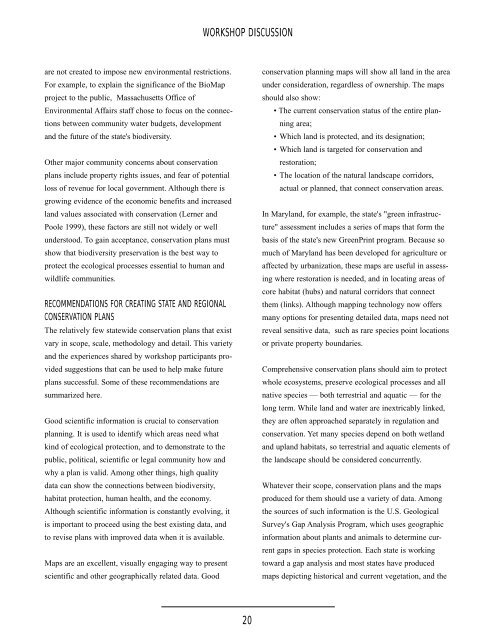Integrating Land Use Planning and Biodiversity - Defenders of Wildlife
Integrating Land Use Planning and Biodiversity - Defenders of Wildlife
Integrating Land Use Planning and Biodiversity - Defenders of Wildlife
Create successful ePaper yourself
Turn your PDF publications into a flip-book with our unique Google optimized e-Paper software.
WORKSHOP DISCUSSION<br />
are not created to impose new environmental restrictions.<br />
For example, to explain the significance <strong>of</strong> the BioMap<br />
project to the public, Massachusetts Office <strong>of</strong><br />
Environmental Affairs staff chose to focus on the connections<br />
between community water budgets, development<br />
<strong>and</strong> the future <strong>of</strong> the state's biodiversity.<br />
Other major community concerns about conservation<br />
plans include property rights issues, <strong>and</strong> fear <strong>of</strong> potential<br />
loss <strong>of</strong> revenue for local government. Although there is<br />
growing evidence <strong>of</strong> the economic benefits <strong>and</strong> increased<br />
l<strong>and</strong> values associated with conservation (Lerner <strong>and</strong><br />
Poole 1999), these factors are still not widely or well<br />
understood. To gain acceptance, conservation plans must<br />
show that biodiversity preservation is the best way to<br />
protect the ecological processes essential to human <strong>and</strong><br />
wildlife communities.<br />
RECOMMENDATIONS FOR CREATING STATE AND REGIONAL<br />
CONSERVATION PLANS<br />
The relatively few statewide conservation plans that exist<br />
vary in scope, scale, methodology <strong>and</strong> detail. This variety<br />
<strong>and</strong> the experiences shared by workshop participants provided<br />
suggestions that can be used to help make future<br />
plans successful. Some <strong>of</strong> these recommendations are<br />
summarized here.<br />
Good scientific information is crucial to conservation<br />
planning. It is used to identify which areas need what<br />
kind <strong>of</strong> ecological protection, <strong>and</strong> to demonstrate to the<br />
public, political, scientific or legal community how <strong>and</strong><br />
why a plan is valid. Among other things, high quality<br />
data can show the connections between biodiversity,<br />
habitat protection, human health, <strong>and</strong> the economy.<br />
Although scientific information is constantly evolving, it<br />
is important to proceed using the best existing data, <strong>and</strong><br />
to revise plans with improved data when it is available.<br />
Maps are an excellent, visually engaging way to present<br />
scientific <strong>and</strong> other geographically related data. Good<br />
conservation planning maps will show all l<strong>and</strong> in the area<br />
under consideration, regardless <strong>of</strong> ownership. The maps<br />
should also show:<br />
• The current conservation status <strong>of</strong> the entire planning<br />
area;<br />
• Which l<strong>and</strong> is protected, <strong>and</strong> its designation;<br />
• Which l<strong>and</strong> is targeted for conservation <strong>and</strong><br />
restoration;<br />
• The location <strong>of</strong> the natural l<strong>and</strong>scape corridors,<br />
actual or planned, that connect conservation areas.<br />
In Maryl<strong>and</strong>, for example, the state's "green infrastructure"<br />
assessment includes a series <strong>of</strong> maps that form the<br />
basis <strong>of</strong> the state's new GreenPrint program. Because so<br />
much <strong>of</strong> Maryl<strong>and</strong> has been developed for agriculture or<br />
affected by urbanization, these maps are useful in assessing<br />
where restoration is needed, <strong>and</strong> in locating areas <strong>of</strong><br />
core habitat (hubs) <strong>and</strong> natural corridors that connect<br />
them (links). Although mapping technology now <strong>of</strong>fers<br />
many options for presenting detailed data, maps need not<br />
reveal sensitive data, such as rare species point locations<br />
or private property boundaries.<br />
Comprehensive conservation plans should aim to protect<br />
whole ecosystems, preserve ecological processes <strong>and</strong> all<br />
native species — both terrestrial <strong>and</strong> aquatic — for the<br />
long term. While l<strong>and</strong> <strong>and</strong> water are inextricably linked,<br />
they are <strong>of</strong>ten approached separately in regulation <strong>and</strong><br />
conservation. Yet many species depend on both wetl<strong>and</strong><br />
<strong>and</strong> upl<strong>and</strong> habitats, so terrestrial <strong>and</strong> aquatic elements <strong>of</strong><br />
the l<strong>and</strong>scape should be considered concurrently.<br />
Whatever their scope, conservation plans <strong>and</strong> the maps<br />
produced for them should use a variety <strong>of</strong> data. Among<br />
the sources <strong>of</strong> such information is the U.S. Geological<br />
Survey's Gap Analysis Program, which uses geographic<br />
information about plants <strong>and</strong> animals to determine current<br />
gaps in species protection. Each state is working<br />
toward a gap analysis <strong>and</strong> most states have produced<br />
maps depicting historical <strong>and</strong> current vegetation, <strong>and</strong> the<br />
20
















![[PDF] Community Development Toolkit - CommDev](https://img.yumpu.com/48616495/1/184x260/pdf-community-development-toolkit-commdev.jpg?quality=85)
